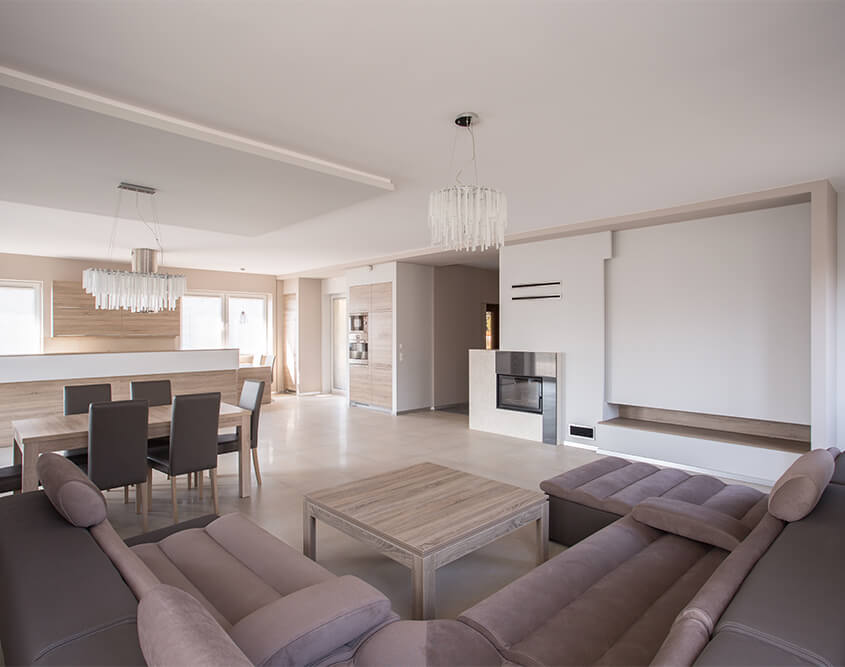Micro-dwelling and downsizing have become popular trends as more people want to simplify their lives by living with less and in smaller quarters. There are numerous advantages to living in a smaller home. There's the low cost of entry, lower operating costs and less cleaning. Smaller areas necessitate less furniture, and they can also feel more welcoming. Overall, tiny homes can be lovely and practical.
Make the best of small and confined spaces by placing your furniture smartly. You can take the help of a friend or family to make your creative juices flow. To get some more ideas, here is all you need to know about making your living area seem more spacious.
1. Flooring
It will make a tremendous difference in the sensation of space if you keep the same flooring type throughout your home. Floorboards are an excellent solution because they can be utilised in various rooms, including living rooms, kitchens, and bedrooms.
Rugs are a great way to bring warmth to a room without visually diminishing it. Avoid anything too ornate when buying a rug and instead opt for a more plain design. For example, a vertically striped rug will provide interest without being overly hectic.
2. Use A Side Table
The trouble about a round coffee table is that they don't come in small sizes. And if you're in a small living room, you'll need every inch of available space. Be smart with your choice of furniture, keep it to a minimum and buy multiple-purpose furniture if possible.
With that in mind, I'd recommend looking for a side table instead. Even better, a set of two side tables would be fantastic. The smaller one will tuck under the larger one since one will be taller than the other. This gives the area a lot of flexibility while also saving space.
3. Use Mirrors
Use mirrors to spread light around the room. Mirrors create the appearance of space by reflecting sunlight and allowing it to bounce around the room.
If wall-to-wall mirrors are too much for you, leaning a few enormous full-length mirrors against a wall or hanging many mirrors on a wall can be just as effective and less permanent.
Artfully place the mirrors to reflect a window and the view outside to steal additional light or enhance your view.
4. Use Lighter Paint Colours
Lighter paint colours reflect natural light, making the space appear larger. On the other hand, darker colours provide a cosier and more intimate atmosphere. A light and neutral colour palette will be more successful if you create a more expansive impression. Pale greys, creams and whites come to mind.
Sticking to one colour rather than establishing feature walls will also help balance your space's proportions. If you want to add some colour variety to the room, paint the skirting, window and door trims a shade lighter than the remainder of the room.
Consider the other surfaces in your space, especially your floors, when choosing your paint colours. You'll want to make sure they're both parts of the same colour scheme. Rather than emphasising the disparities in surfaces, this will provide visual cohesiveness and balance.
5. Take The Doors Off
Taking interior doors off may be an option if smashing through walls to make larger apertures isn't an option. It can take up valuable floor space and disrupt the flow of your home if your doors open into a room. You can either remove the door entirely or replace it with a sliding door.
In small spaces, every millimetre counts. This simple change could also work well in rooms with cupboards on a hinge such as bedroom closets or bathroom cabinetry. Use sliding doors and windows that open up the space and allow light to enter your home.
6. Minimise Window Accessories
Decorative double glazed window treatments, such as valances and curtains, made of luxury materials take up valuable real estate in compact rooms and make a room feel smaller.
Instead, choose simple window treatments like rolling blinds in the same fabric as the walls. You'll be able to cover the window without taking up too much room.
If you want to hang curtains, another option is to place a track on the ceiling rather than the walls. To emphasise the height of your room, use a light fabric like linen and hang the curtains to the floor.
To make your tiny rooms feel spacious and airy, all you need is a little effort and a lot of imagination and ingenuity. You may have a lot of fun with your furniture, walls, interior décor, lighting and mirrors. So, go ahead, let that creativity flow and make your room spacious.









Social Profile